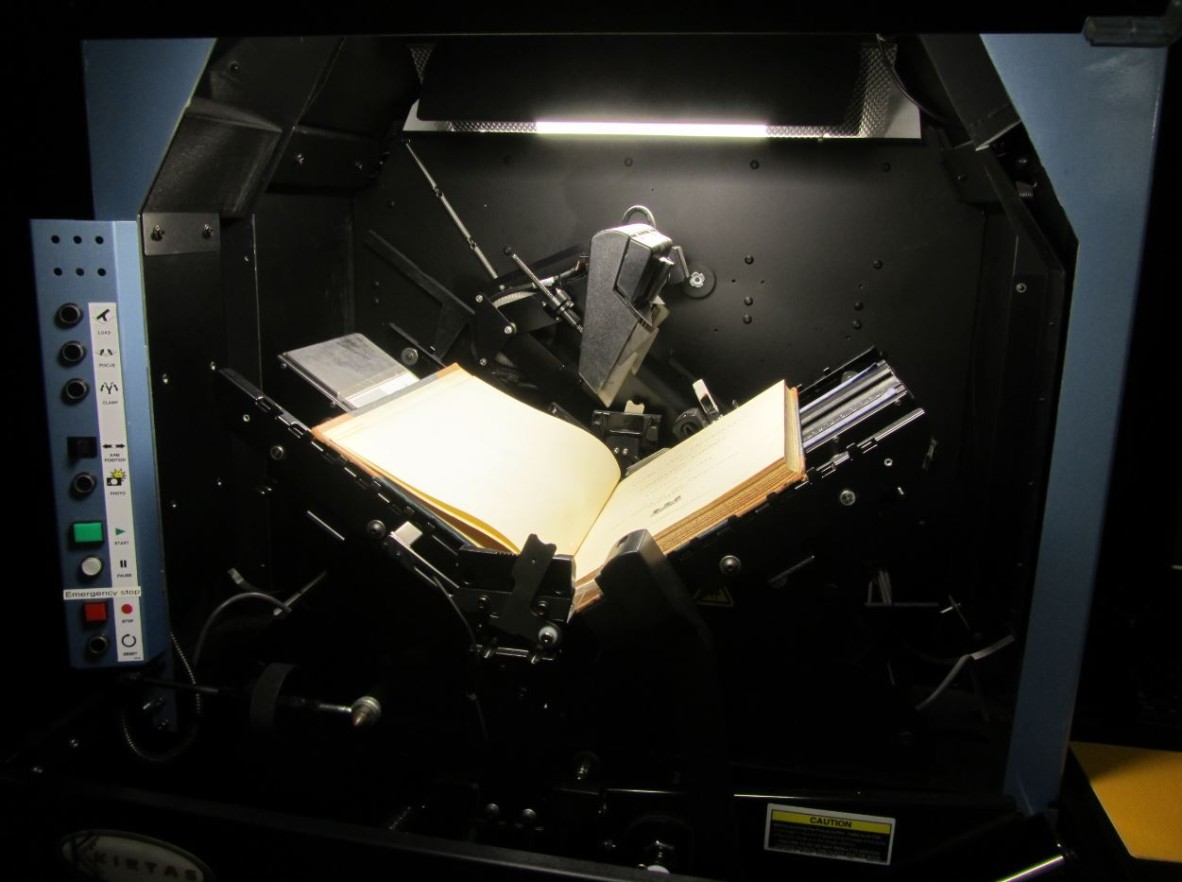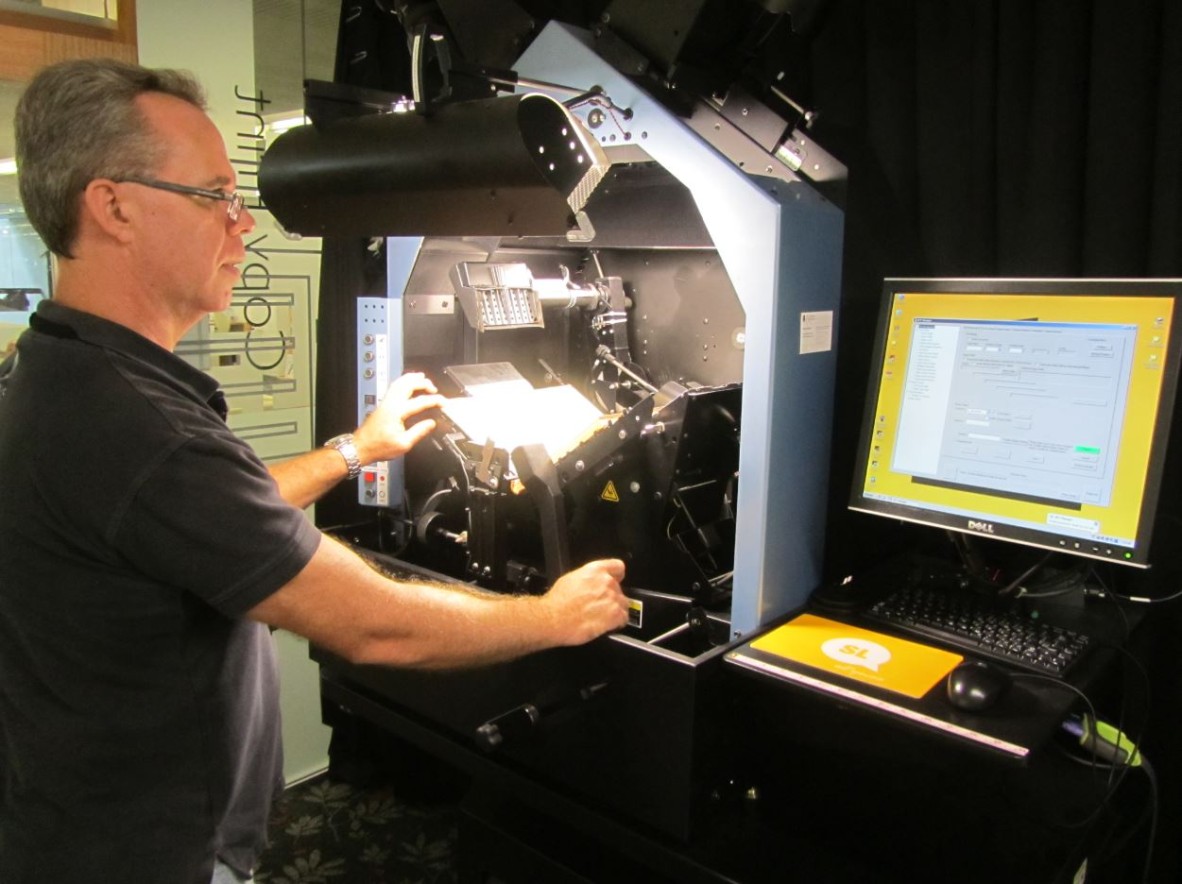Visitors to State Library of Queensland can now see our recent acquisition, a digital book scanner, in action. Located in the glass-walled Digital Hub of SLQ’s Level 1 Infozone, the robotic scanner is clearly visible, enabling everyone to see SLQ’s digitisation work in progress.
By digitising items in our collection, we can increase access to that material, as digitised pages can be made accessible online while preserving the original copy.
The Kirtas APT Bookscan 2400 RA machine scans and turns the pages of a book, and imaged pages are then processed by BookScan Editor, a program on the PC where the scanned images are stored.

Kirtas book scanner. Image by SLQ staff.
The Kirtas machine can scan books up to a maximum size of 354mm x 278mm and a minimum size of 177mm x 113mm. The book is supported in a V-shaped cradle angled at 45 degrees, which holds the open book and keeps pages in focus. A page-flattening clamping system holds the open pages in place under a florescent lighting system, as two 20-megapixel Canon EOS cameras capture the page images. A mechanised page-turning arm uses a vacuum head to lightly grip the pages, which are gently separated by a fluffer arm that blows air at the page edges to separate them and prevent the page-turning arm from picking up multiple pages.
Although the page-turning arm’s gentle vacuum system can handle pages delicately, the scanner is not suitable for books with severe acidic damage or particularly thin paper. This means that the scanner will be used mainly for published items and any robust original material. Some tightly bound books, or books with printing close to the gutters, top or bottom edges of the pages, may not be suitable candidates for use in the scanner.
While the Kirtas book scanner is automated, an operator needs to set it up according to the book size, select the scan speed (up to 2,400 pages an hour), and select which pages are to be scanned when the book is open (left, right or both). The closed book is loaded into the cradle, and a manual image is taken of the front cover. After checking the image quality, the operator opens the book, sets the clamps, and centres the gutter of the book by lining it up with a red laser dot. The machine is focussed again, and a manual scan is taken and checked for quality. The first page is turned by hand, and the page-flattening clamps and fluffer arm are positioned. Once everything is ready to go, the operator presses the start button to commence the automatic scanning process.
During scanning, the cradle is monitored and adjusted to keep the book centred, newly turned pages are flattened by hand if necessary, and the page turning is monitored for any missed pages caused by picking up multiple pages. If pages are missed, the machine is paused, the clamps raised, and the missed pages opened. Any out-of-order pages are then deleted before the automatic scanning is recommenced.
When the entire book has been scanned, the images are checked for any missing pages. If any pages have been missed, they will be scanned manually before the book is removed from the machine.
The BookScan Editor program automates the processing of images. From a single left and right page scan, the flattening clamps are digitally removed from the images, and page images are cropped. These changes can then be applied automatically to the remaining page images. Several of these batch changes can be set up to run overnight, as it is time consuming (a 400 page book can take one to two hours to process) and no user intervention is required. Completed batches are checked, and any necessary manual processing is done to complete the job.
Once all images meet SLQ standards, they are saved and ready to form part of our digital collection.

SLQ Preservation Assistant, Robert French, using the Kirtas book scanner. Image by SLQ staff.
Come along to our Digital Hub in the Level 1 Infozone to see this fascinating process for yourself.
State Library also has an array of other equipment for digitising physical collections, including:
- autofeed scanner (robust loose leaf papers)
- Zeutschel archival book scanner (fragile bound manuscripts and publications)
- large format scanner (maps, plans, drawings, posters etc)
- flat bed scanners (paper records and photographs)
- Hasselblad high resolution digital camera (delicate and fine detail items)
- AV tower (converting analogue AV collections)
- Steenbeck (viewing the contents of original Qld motion picture films).
Digitised collections can be searched in our One Search catalogue and are freely available.
Visit us: /visit-us
http://onesearch.slq.qld.gov.au/Join us: /services/membership/how-to-join
Comments
Your email address will not be published.
We welcome relevant, respectful comments.